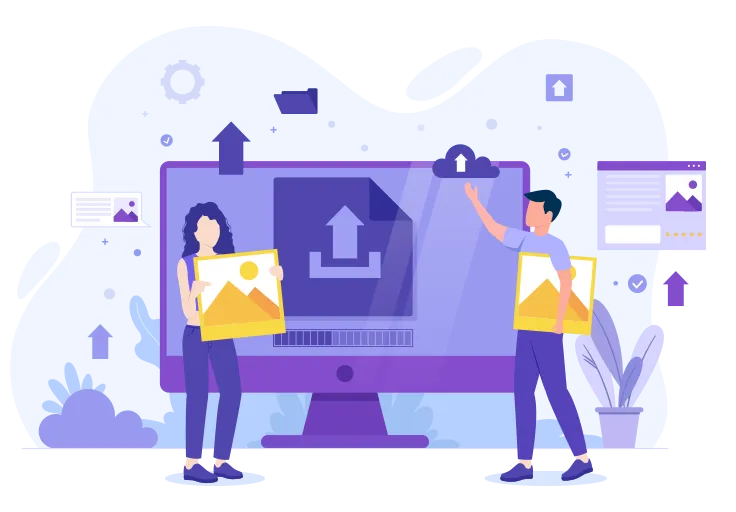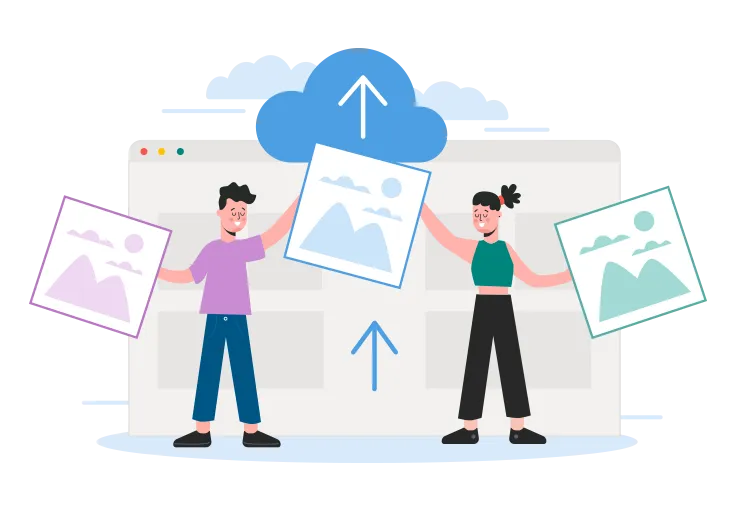
Our WebP to AVIF Conversion Guide
Converting from WebP to AVIF format offers extraordinary advantages for web optimization and performance. While WebP already provides excellent compression, AVIF takes image optimization to the next level with even smaller file sizes and superior quality retention. In this guide, we'll explore how to efficiently convert your WebP images to AVIF format, the key differences between these modern formats, and when you should choose AVIF over WebP for your specific needs.
What Do WebP and AVIF Formats Mean?
WebP Format
WebP is a modern image format developed by Google that offers both lossy and lossless compression. It was designed specifically for web use, providing smaller file sizes compared to traditional formats while maintaining visual quality. WebP supports transparency and animation features, making it versatile for web applications. Since its introduction in 2010, WebP has gained significant adoption for web optimization strategies.
AVIF Format
AVIF (AV1 Image File Format) is an even newer image format based on the AV1 video codec. It represents the cutting edge in image compression technology, offering superior compression efficiency compared to both traditional formats and WebP. AVIF delivers exceptional image quality at remarkably small file sizes, supports alpha channel transparency, HDR, and wide color gamuts. While still gaining browser adoption, AVIF is rapidly becoming the preferred choice for forward-thinking web developers and content creators who prioritize both quality and performance.
images.tr offers a powerful WebP to AVIF converter that helps you achieve next-generation image optimization with just a few clicks.

Free, Batch, and Fast WebP to AVIF Conversion with images.tr
Converting from WebP to AVIF requires advanced processing capabilities to ensure optimal quality and compression. images.tr offers a state-of-the-art service that allows you to convert your WebP images to AVIF format with exceptional results. Our powerful platform is completely free to use, with no hidden fees, watermarks, or limitations on the number of conversions.
Advantages of images.tr:
- 100% Free Service: All features are available at no cost, with absolutely no watermarks or premium tiers.
- Superior Compression: Our conversion delivers AVIF files that are typically 20-30% smaller than WebP while maintaining similar or better visual quality.
- Transparency Support: All transparent elements in your WebP images are preserved in the AVIF conversion with improved efficiency.
- Batch Processing: Convert multiple WebP files to AVIF simultaneously, saving significant time on large collections.
How to Convert WebP to AVIF with images.tr?
- Upload your WebP files using our simple drag-and-drop interface or file selector.
- Select AVIF as your target format from the available options.
- Start the conversion process with a single click on the "Convert" button.
- Download your newly converted AVIF files individually or as a batch in a ZIP archive.
Batch Image Processing: Perfect for Web Developers and Performance Optimization
The batch processing capability of images.tr is particularly valuable for web developers, site owners, and content creators working with multiple images. Convert entire libraries of WebP images to AVIF format in one simple operation, achieving maximum compression across all files while saving hours of manual work.
Advanced Conversion Algorithm:
Our conversion engine is fine-tuned to produce AVIF files that strike the perfect balance between file size reduction and visual quality. Whether you're optimizing images for a high-traffic website, preparing assets for a progressive web application, or experimenting with cutting-edge image formats, our WebP to AVIF converter delivers superior results every time.

Everything is very easy with images.tr!
Converting from WebP to AVIF is remarkably simple with our user-friendly platform. No technical expertise or specialized software is required - our intuitive interface guides you through the process effortlessly. images.tr is designed to accommodate both casual users and professionals with its powerful yet simple conversion process.
By upgrading from WebP to AVIF, you're embracing the future of web image optimization. WebP to AVIF conversion ensures your images will deliver the smallest possible file sizes while maintaining excellent visual quality. The process is quick and seamless, allowing you to focus on creating exceptional web experiences rather than worrying about technical conversion processes.
What Are the Differences Between WebP and AVIF?
Understanding the key differences between WebP and AVIF formats helps you make informed decisions about which format to use in different situations:
Advantages of WebP Format:
- Better browser support across platforms
- Faster encoding and decoding speed
- Still offers good compression compared to older formats like JPEG and PNG
- Animation support similar to GIF but more efficient
- Well-established in the web development ecosystem
Advantages of AVIF Format:
- Superior compression efficiency (20-30% smaller than WebP for similar quality)
- Better preservation of details at very low file sizes
- Enhanced HDR and wide color gamut support
- Improved alpha channel transparency handling
- Better quality-to-size ratio for photographic content
- Cutting-edge technology representing the future of image optimization


Why Should You Convert from WebP to AVIF?
There are several compelling reasons to convert your WebP images to AVIF format:
- Maximum Compression: AVIF offers significant additional file size reduction beyond what WebP can achieve, typically 20-30% smaller for the same visual quality.
- Superior Quality at Low Bitrates: When extreme compression is needed, AVIF maintains better visual quality than WebP at very low file sizes.
- Future-Proofing: As browser support increases, AVIF is positioned to become the new standard for web image optimization.
- Better HDR Support: For images with high dynamic range, AVIF provides superior encoding capabilities.
- Improved Core Web Vitals: The smaller file sizes of AVIF can help improve your website's Largest Contentful Paint (LCP) scores, benefiting SEO.
- Enhanced Mobile Experience: Smaller image sizes mean faster loading and less data consumption for mobile users.
- Competitive Edge: Early adoption of cutting-edge technologies like AVIF can give your website a performance advantage.
Common Usage Areas of WebP and AVIF
- WebP: General web use, e-commerce platforms, content management systems, progressive web apps, and situations where broad browser compatibility is essential.
- AVIF: Performance-critical websites, modern web applications, content delivery networks, mobile-optimized sites, and any platform where maximum compression and quality are priorities.
Things to Consider When Converting from WebP to AVIF
- Browser Support: While AVIF support is growing rapidly, you may need fallback options for older browsers. Consider using the HTML picture element with source tags to provide alternatives.
- Processing Resources: AVIF encoding can be more computationally intensive than WebP, though this only affects the conversion process, not the end-user experience.
- Animation Limitations: AVIF's animation capabilities are still evolving. For animated content, evaluate whether WebP might still be more appropriate.


Implementing AVIF Images After Conversion
After converting your WebP files to AVIF format, consider these best practices for implementation:
- Use the HTML picture element with source tags to provide AVIF as the primary format with WebP and JPEG fallbacks for browsers that don't support AVIF.
- Consider implementing lazy loading for images to further enhance page performance.
- Use appropriate width and height attributes on images to prevent layout shifts during page loading.
- Test your AVIF implementation across different browsers to ensure compatibility.
- For content delivery networks (CDNs), check if they support automatic format negotiation to serve AVIF to compatible browsers.
Example HTML implementation:
<picture> <source type="image/avif" srcset="image.avif"> <source type="image/webp" srcset="image.webp"> <img src="image.jpg" alt="Description" width="800" height="600"> </picture>
Exceptional Performance with WebP to AVIF Conversion
Converting from WebP to AVIF represents a strategic investment in cutting-edge web performance. While WebP already offers excellent optimization compared to traditional formats, AVIF takes compression efficiency to new heights while maintaining exceptional visual quality.
When AVIF is the Right Choice:
- Performance-Critical Applications: For websites where every kilobyte matters and loading speed is paramount.
- Mobile-First Websites: When optimizing for mobile users with potentially limited bandwidth or data plans.
- High-Volume Image Hosting: When serving large quantities of images where bandwidth savings can be substantial.
- Visual Quality at Low Bitrates: When you need to maintain excellent quality despite aggressive compression.
- Forward-Looking Projects: For websites and applications intended to leverage the latest web technologies.

Take Your Web Performance to the Next Level with WebP to AVIF
Converting your WebP images to AVIF format with images.tr empowers you to implement the very latest in image optimization technology. By adopting AVIF now, you're positioning your website at the forefront of web performance, potentially gaining advantages in both user experience and search engine rankings. The transition from WebP to AVIF represents a natural evolution in the pursuit of faster, more efficient web content delivery.
Whether you're a performance-focused web developer, a digital marketer seeking to improve core web vitals, or a content creator wanting to deliver the best possible visual experience with minimal bandwidth, WebP to AVIF conversion offers compelling benefits. With images.tr's powerful yet simple tools, you can convert your entire image collection with confidence, embracing the future of web image optimization today.
Frequently asked questions about WEBP
What is WEBP?
WEBP is a modern image format that offers high compression rates and quality images. It supports both lossy and lossless compression.
How can I compress WEBP files?
You can compress WEBP files using online tools or software; this preserves quality while reducing file size.
What are the advantages of WEBP?
WEBP provides smaller file sizes and faster loading times compared to JPG and PNG, making it ideal for websites.
Which formats can I convert WEBP files to?
You can convert WEBP files to JPG, PNG, AVIF, and HEIC formats. Each format offers different advantages for specific uses.
Does WEBP support transparency?
Yes, WEBP supports alpha channel transparency similar to PNG but with smaller file sizes.
What browsers support WEBP?
Most modern browsers including Chrome, Firefox, Edge, and Safari support WEBP. However, some older browsers may require alternative formats.
Does WEBP work on mobile devices?
Yes, most modern mobile devices and browsers support WEBP, but compatibility should be checked for older devices.
How is WEBP different from JPG?
WEBP offers better compression than JPG and supports transparency. It provides similar quality images at smaller file sizes.
Can I convert JPG to WEBP?
Yes, you can convert JPG to WEBP using various online tools or software. This often results in smaller file sizes.
What is the typical file size reduction with WEBP?
WEBP typically reduces file sizes by 25-35% compared to JPG, and significantly more compared to PNG files with transparency.
How does WEBP impact SEO and website performance?
WEBP images can improve page loading speed, which positively affects SEO rankings. Faster websites also provide better user experience.
How does WEBP compare to AVIF?
AVIF generally offers better compression than WEBP, but WEBP has wider browser support. AVIF is newer and still gaining adoption.
Can I resize WEBP images?
Yes, you can resize WEBP images just like any other image format using various online tools or image editing software.
Frequently asked questions about AVIF
What is AVIF?
AVIF is a modern image format that offers high-quality images with smaller file sizes. It supports both lossy and lossless compression.
What are the advantages of AVIF format?
AVIF provides better compression ratios and higher image quality, making it ideal for websites.
Which formats can I convert AVIF files to?
You can convert AVIF files to formats like JPG, PNG, WEBP, and HEIC.
What browsers support AVIF?
Chrome, Firefox, and many Chromium-based browsers support AVIF. Some browsers may require updates or additional plugins for compatibility.
What is the compression ratio of AVIF format?
AVIF can achieve 30-50% better compression compared to JPEG and 20-30% better than WEBP for similar image quality.
How does AVIF affect website performance?
AVIF improves website performance by reducing load times with smaller file sizes while maintaining high quality, resulting in better user experience.
Does AVIF support transparency?
Yes, AVIF supports alpha channel transparency, similar to PNG but with more efficient compression.
How is AVIF different from WEBP?
AVIF generally offers better compression and quality than WEBP, but WEBP currently has better browser support. AVIF is newer and still gaining widespread adoption.
Can I convert JPG to AVIF?
Yes, you can convert JPG to AVIF using various online tools or software, resulting in smaller file sizes with similar quality.
What are the limitations of AVIF?
Limited browser support is the main limitation of AVIF. Additionally, encoding AVIF images can be more processor-intensive than other formats.
Is AVIF supported on mobile devices?
AVIF is supported on newer mobile devices, especially those with Chrome or Android browsers, but support varies by device and operating system.
How can I optimize AVIF files?
You can optimize AVIF files by adjusting compression settings, choosing appropriate quality levels, and using specialized optimization tools.
Published on .